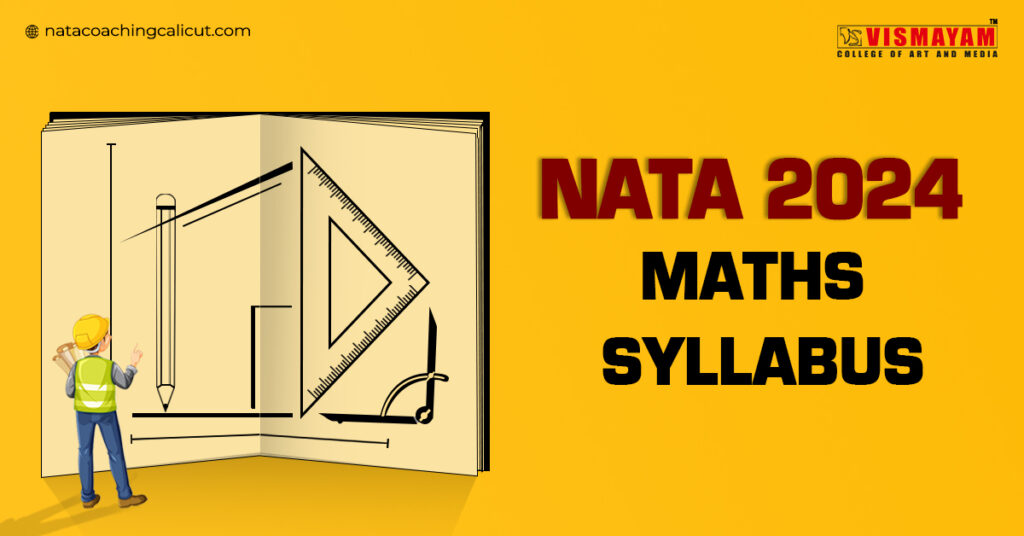NATA Mathematics Syllabus 2024

Starting on the path to becoming an architect is an exciting and rewarding journey that begins with earning a Bachelor of Architecture (BArch) degree. This degree equips aspiring architects with the knowledge, skills, and creativity necessary to design and construct buildings that shape the world around us. Aspiring architects must navigate the challenges of the NATA exam, and a crucial component of this journey is mastering the NATA maths syllabus 2024.
About BArch Degree
A BArch degree is a professional undergraduate program that typically spans five years. It blends rigorous coursework with hands-on design projects, technical training, and architectural theory. Throughout the program, students delve into various aspects of architecture, including design principles, construction technology, environmental sustainability, and urban planning.
NATA exam 2024
The NATA exam is a crucial milestone on the path to obtaining a BArch degree. It evaluates candidates’ aptitude in various aspects of architecture, including drawing skills, aesthetic sensitivity, and mathematical proficiency. Aspiring architects must excel in the NATA exam to secure admission to prestigious architecture schools and universities. The exam consists of multiple sections, each designed to assess different aspects of a candidate’s capabilities.
NATA Maths Syllabus
Mathematics is a major in architecture, it is serving as the foundation for structural analysis, spatial planning, and design optimization. The NATA maths syllabus 2024 encompasses topics such as:
Geometry and Trigonometry:
Candidates must demonstrate proficiency in geometric principles and trigonometric functions. Understanding concepts such as angles, shapes, and spatial relationships is essential for architectural design.
Trigonometric functions
Addition and Subtraction formulae
Formulae involving multiple and submultiple angles
The general solution of trigonometric equations.
Properties of triangles
Inverse trigonometric
Functions and their properties
Coordinate Geometry:
Distance formula
Section formula
Area of a triangle
Condition of collinearity of three
Points in a plane
Polar coordinates
The transformation from Cartesian to polar coordinates and vice versa
Parallel transformation of axes
Concept of locus
Elementary locus problems
The slope of a line
Equation of lines in different forms
Angles between two lines
Condition of perpendicularity and parallelism of two lines
Distance of a point from a line
Distance between two parallel lines
Lines through the point of intersection of two lines.
Equation of a circle with a given center and radius
A condition that a general equation of second degree in x, y may represent a circle
Equation of a circle in terms of endpoints of a diameter
Equation of tangent
Normal and Chord
Parametric equation of a circle
The intersection of a line with a circle
Equation of the common chord of two intersecting circles.
3-dimensional coordinate geometry
Direction cosines and direction ratios
Distance between two points and section formula
Equation of a straight line
Equation of a plane
Distance of a point from a plane.
Algebra:
Algebraic concepts, equations, and functions are integral to architectural calculations and problem-solving. Candidates should be comfortable with manipulating algebraic expressions and solving equations to tackle complex design challenges.
Definitions of A. P. and G.P.
General term
Summation of first n-terms of series ∑n, ∑n², ∑n3
Arithmetic/Geometric series, A.M., G.M., and their relation
Infinite G.P. series and its sum.
Coordinate Geometry:
Knowledge of coordinate systems and geometric transformations is essential for representing and manipulating spatial data in architectural drawings and models.
Calculus
Functions are the composition of two functions and inverse functions.
Limit
Continuity
Derivative
Chain rule
Derivatives of implicit functions and functions defined parametrically
Integration as a reverse process of differentiation
The indefinite integral of standard functions
Integration by parts
Integration by substitution and partial fraction
Definite integral as a limit of a sum with equal subdivisions
Fundamental theorem of integral calculus and its applications
Properties of definite integrals
Formation of ordinary differential equations
Solution of homogeneous differential equations
Separation of variables method
linear first-order differential equations
Logarithms
Definitions
General properties
Change of base
Matrices
Operations of addition
Scalar multiplication and multiplication of matrices.
Transpose of a matrix.
Determinants of a square matrix.
Properties of determinants (statement only).
The minor, cofactor, and adjoint of a matrix.
Nonsingular matrix.
The inverse of a matrix.
Finding the area of a triangle.
Solutions of a system of linear equations.
Permutation & Combination
Permutation of n different things taken r at a time (r ≤ n). Permutation of n things is not all different.
Permutation with repetitions (circular permutation excluded).
Combinations of n different things taken r at a time (r ≤ n).
The combination of n things is not all different.
Basic properties. Problems involving both permutations and combinations.
Statistics
Measurement of dispersion, mean, variance, standard deviation, and frequency distribution.
Addition and multiplication rules of probability
Conditional probability and Bayes’ Theorem
Independence of events
Repeated independent trials
Binomial distribution.
How to Prepare
Preparation for the NATA exam requires a strategic approach and diligent practice. To excel in the mathematics section, candidates should:
Understand the Syllabus: Familiarize yourself with the NATA maths syllabus for 2024 and identify areas where you need improvement.
Practice Regularly: Dedicate time to practicing mathematical problems and exercises regularly to reinforce your understanding and problem-solving skills.
Seek Guidance: Utilize resources such as textbooks, online tutorials, and practice tests to supplement your learning and seek guidance from experienced mentors or tutors if needed.
Review and Revise: Continuously review and revise mathematical concepts in the NATA maths syllabus 2024 to ensure retention and mastery before the exam.
Also Read:
NATA Preparation Tips and Strategies For Mathematics Based On Latest Exam Pattern
NATA Preparation Tips and Strategies For Drawing Based On Latest Exam Pattern
NATA Preparation Tips and Strategies For General Aptitude Based On Latest Exam Pattern
NATA 2024 Exam Date has been announced. Exam will be held on 6th April 2024
Vismayam Coaching Centre competent instructors with comprehensive, up-to-date knowledge can help candidates achieve the highest possible score in competitive exams such as NATA. Our NATA Study Materials are also highly regarded among aspirants due to their simplicity and comprehensiveness. For NATA exam preparation, we offer a variety of course modules. We have a fantastic faculty panel in terms of study and sections of the course. They have extensive experience and are graduates of prestigious design and architecture schools.
